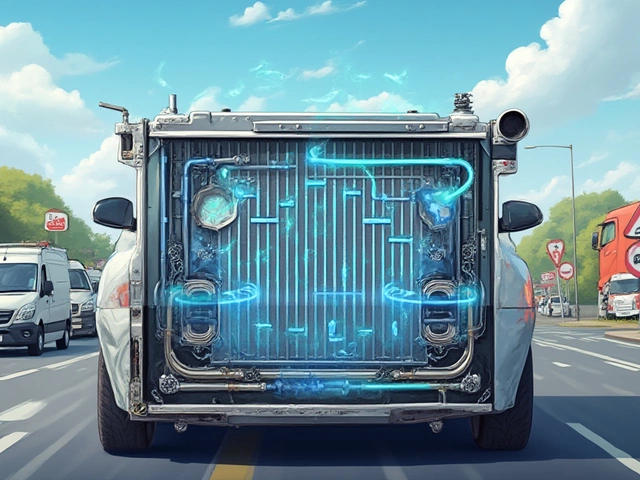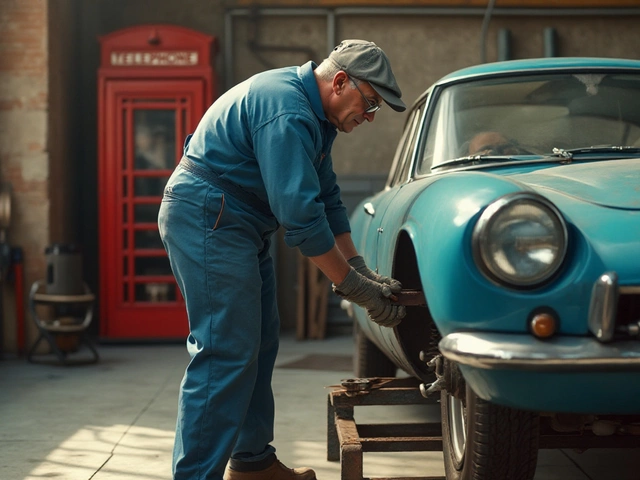Ever been caught in a sudden downpour and realized your windshield wipers are basically smearing mud instead of clearing rain? That’s a surefire sign they’re past their prime. Most drivers are surprised to learn that, on average, windshield wipers only last between 6 to 12 months. So if you can’t remember the last time you changed them, you’re probably overdue.
It doesn’t matter if your car lives in a city garage or outside in the sun; wiper blades are always working against the clock. Sun exposure, freezing temps, and even just regular use all break them down over time. Ignore them too long, and that annoying streak turns into a real safety risk.
- What’s the usual lifespan?
- Why do some wipers wear out faster?
- Top signs your wipers need replacing
- Tips to make wipers last longer
- Choosing the right replacement blades
- Summer, winter, and climate impact
What’s the usual lifespan?
If you ask around at any local auto shop, most folks will tell you that windshield wipers last anywhere from 6 months up to a year. But it’s not just a random estimate. Several big auto parts makers—even Michelin and Bosch—recommend swapping wiper blades twice a year. The rubber on the blade just isn’t built to handle endless sun, freezing nights, or daily grime without breaking down.
It’s not just the brand or price that matters. Where you live and how you use your car play a huge role. In places with lots of rain or snow, windshield wiper lifespan can be on the lower end. Park your car outside all year round? The sun and weather are working against the blades every day. And if you don’t use them much, the rubber can still harden and crack just from sitting there.
| Climate | Average Lifespan |
|---|---|
| Wet/Rainy Regions | 6-9 months |
| Sunny/Hot Areas | 4-8 months |
| Cold/Snowy Zones | 5-10 months |
| Garage-Kept Vehicles | 9-12 months |
Don’t trust your memory to keep track. Most drivers forget until their vision’s suddenly a mess. Mark your calendar after each change. Some folks use seasonal changes—spring and fall—as easy reminders. It’s a simple move, but it keeps you out of trouble when that next surprise storm rolls in.
Why do some wipers wear out faster?
You might notice your buddy's wipers last way longer than yours, even though you both drive around the same town. What’s going on? Turns out, a bunch of everyday things team up to speed up wiper wear and tear.
Let’s break down the big reasons:
- Sunlight (UV Rays): Parking outside, even a few days a week, exposes your wipers to harsh UV rays. This dries out the rubber and makes blades crack way sooner.
- Weather Extremes: Freezing winters or blazing summers will wreck wipers fast. Cold turns rubber stiff and brittle, while heat cooks and warps it.
- Using Wipers on a Dry Windshield: Hitting the wiper switch when your windshield is bone dry? That drags the blade across glass, shaving months off their life.
- Dirt and Debris: Grit and sand on the windshield act like sandpaper, eating away at the blade.
- Poor Washer Fluid: Cheap or old washer fluid can leave residue, forcing your blades to work harder (and making things worse if there’s alcohol in it—alcohol dries out rubber).
- Driving Habits: Heavy city traffic, frequent stops, and long commutes mean more wiper action, so the blades just wear out from overuse.
Here’s a quick look at what kills wipers the fastest:
| Factor | Wiper Lifespan Impact | Example |
|---|---|---|
| Constant Sun/Heat | Up to 50% shorter | Parked outside all summer |
| Freezing Temps | Cracking in under 6 months | Leaving wipers frozen to glass |
| Dry Use | Serious streaking within weeks | Clearing dust, not rain |
| Mud & Debris | Jagged scraping & splits | Country roads, dusty jobsites |
If you care about your windshield wiper lifespan, just know that Mother Nature and your own driving habits are pretty tough on those thin strips of rubber. Being aware of what ages them will help you keep your vision clear when it matters most.
Top signs your wipers need replacing
Don’t wait until you can hardly see through your windshield before checking your wipers. Catching the early warning signs saves you headaches, keeps you safer, and might even help your wipers last a little longer. Here’s what you need to watch out for:
- Streaking or Skipping: If your blades leave streaks, patches, or start jumping across the glass, that’s a classic sign they’re worn out. No one likes a smeared view, especially during a downpour.
- Squeaking Noises: Squeaking isn’t just annoying. When the wipers squeal, the rubber is probably dried out or hard, making poor contact with the windshield.
- Splitting or Cracked Blades: A quick look at your blades will reveal splits, cracks, or even pieces of rubber missing. Once you see this, it’s time to replace them—don’t tough it out.
- Chattering: If your wipers chatter or bounce instead of gliding smoothly, the blade may be warped, or the rubber has lost its flexibility.
- Missed Spots: When parts of your windshield stay wet or dirty every time the wipers go by, they're just not cutting it anymore. Consistent clean sweeps should be the norm; anything less means they're shot.
- Worn Edges: If the wiper blade edge feels uneven or sharp instead of smooth, you’re overdue for new blades.
Some car experts say about 90% of drivers don’t replace their wipers until vision is already compromised, which isn’t smart. Here’s a quick table showing how often drivers notice common issues versus how often they replace wipers:
| Symptom | % of Drivers Who Notice | % Who Replace Right Away |
|---|---|---|
| Streaks or Skipping | 75% | 35% |
| Squeaking | 88% | 50% |
| Cracks or Splits | 90% | 60% |
| Chattering | 62% | 30% |
Bottom line: Don’t put off swapping your windshield wiper lifespan by ignoring these signs. Clear vision is non-negotiable.

Tips to Make Wipers Last Longer
Getting the most out of your windshield wipers isn’t just about saving a few bucks. Clear wipers mean safer driving. Here’s how you can squeeze more lifespan out of those blades before you need a new set.
- Windshield wiper lifespan hinges a lot on simple care. Always clean your windshield and the blades themselves. Dirt and grit can chew up the rubber edge fast, leaving you with streaks and skipping long before the blades hit their "expiration date".
- If you live where it gets icy, never use your wipers to clear frozen windshields. That’ll wreck them in no time flat. Use a scraper and get the glass defrosted first.
- Park in the shade or use a windshield cover if you can. UV rays break down rubber fast, and parking in hot sun is the top reason wipers get hard and crack early.
- Lift your wipers up off the glass if you know an ice storm or heavy snow is coming. This stops the blades from freezing to the windshield, which can tear off the rubber strip the next time you try to use them.
- Go easy with windshield cleaners. Some harsh fluids or chemicals, especially with ammonia, dry out the rubber faster.
- Replace both blades at the same time, even if one looks “fine.” The other is probably not far behind in wear, and mismatched wipers can leave weird streak patterns.
The payoff? According to a study from Consumer Reports, regular cleaning and parking in the shade can make wipers last up to 50% longer than average. Here’s a quick look at how simple habits pay off:
| Habit | Expected Lifespan Increase |
|---|---|
| Regular blade cleaning (weekly) | 25% longer |
| Parking in shade | 20% longer |
| Preventing ice buildup | Up to 1 extra year |
| Using proper washer fluid | 10% longer |
The bottom line: baby those wipers a little, and you’ll waste less cash and dodge the panic of a smeared windshield during the next surprise rainstorm.
Choosing the right replacement blades
Picking the right wiper blades isn’t hard, but most people guess or grab whatever’s on sale. That can leave you with blades that squeak, skip, or leave streaks—which defeats the whole purpose. To keep your windshield clear, you need to match the right size, style, and fit for your car.
First, check your owner’s manual or measure your old blades to get the exact length for each side. Most cars use two different sizes, so don’t assume both blades are the same. A lot of stores have a chart or an online tool where you plug in your car’s make, model, and year to get the right sizes.
Next, decide what type of blade suits your needs. Here are the main options:
- Traditional frame-style blades: The most common and cheapest. They work fine in normal weather but can freeze up in winter.
- Beam blades: These are more flexible with no exposed metal parts. Great in harsh weather because they don’t collect ice and hug the windshield better.
- Hybrid blades: Blend features from both frame and beam blades. These work well if your area sees lots of rain with some snow.
If you want worry-free installation, look for blades that come with multiple adapters or are labeled “universal.” They snap onto most wiper arms without tools.
Cheap blades can wear out fast or miss parts of the glass. Spending a little extra gives you a smoother, quieter swipe and fewer headaches down the road. That way, whenever you think about windshield wiper lifespan, you’ll know you made a solid pick from the start.
Summer, winter, and climate impact
Weather is one of the fastest ways to wreck a good set of wipers. Hot summers can make the rubber crack and dry out in less time than most folks expect. Parking outside when it’s 90°F or above? You’re speeding up the wear for sure. Direct sunlight basically bakes the rubber, leaving you with brittle, useless blades.
Then winter comes along and it's just as rough—just in a different way. Freezing temps can make blades stiff and cause them to split or tear if they’re frozen to the windshield. Scraping ice using your windshield wiper also shortens their life big time. The rubber just can’t handle that kind of abuse.
Here’s a quick look at how long you can expect wipers to last in different climates:
| Climate | Average Wiper Lifespan | Main Issues |
|---|---|---|
| Hot/Dry (Desert, Southwest) | 3-6 months | Cracking & drying from heat |
| Cold/Snowy (Northern states, Canada) | 4-8 months | Stiffness, splitting, ice damage |
| Wet/Mild (Pacific Northwest, UK) | 6-12 months | Mildew, constant use wear |
If you deal with dust storms or salty, coastal air, those can do extra damage too. Salt from roads or ocean spray eats away at rubber and metal parts, so if you live near the beach or where it snows, check them even more often.
- Try to park in the shade or a garage in summer.
- In winter, lift your wipers off the windshield before a storm to keep them from sticking.
- Never use your wipers to clear ice—use a scraper.
- Clean your blades with a damp cloth regularly to get rid of grime, sand, and salt.
The bottom line? The harshest climates usually mean replacing wiper blades sooner than the average. Watching for climate damage can save you from a sudden loss of vision on the road.






